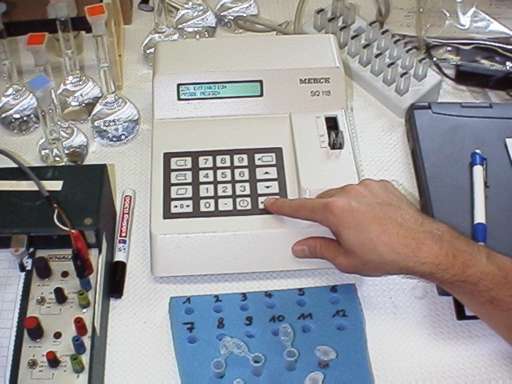| note! | sulfide
is volatile ! Both samples and standards have to be
preserved immediately. Sulfide is preserved by
precipitation as ZnS by addition of sufficient amounts of
zinc acetate. For preservation mix 1.5 mL sample with 0.5
mL ZnAc solution (see below) (=dilution factor of 1.33).
2mL or 4 mL glass vial with screw cap. This is enough to
precipitate the sulfide from 1.5 mL samples with up to 450
ppm sulfide (approx. 14 mM/L). Before taking an aliquot
for measurement shake well (use ultrasonic bath if the
precipitate does not form an evenly distributed cloud). We now usually do a second more diluted aliquot already upon sampling: 100 ÁL sample + 900 ÁL of ZnAc. In case the concentration is high, it is easier and more precise to work directly from a more diluted sample than trying to dilute the sample with the ZnS precipitate. |
|||||||||||||||||||||||||||||||||
| method | Dimethyl-p-phenylene-diamine
forms an intermediate with hydrogen sulfide that
transforms to leucomethylene blue. Leucomethylene blue is
oxidized to methylene blue by ferric iron.
Reference: Cline (1969) Limnology and Oceanography https://doi.org/10.4319/lo.1969.14.3.0454 |
|||||||||||||||||||||||||||||||||
| setup | 
|
|||||||||||||||||||||||||||||||||
| solutions | ||||||||||||||||||||||||||||||||||
| color reagent |
Dissolve
0.4 g N,N-Dimethyl-1,4-phenylenediammonium dichloride (C8H12N2
*Ě 2HCl Merck # 103067, MW 209.12) in 100 mL 10 molar
hydrochloric acid (HCl, 30%). |
|||||||||||||||||||||||||||||||||
| catalyser solution |
Dissolve 1.6 g FeCl3* 6 H2O (Merck
#103943, MW 270.33) in 100 mL 10 molar hydrochloric acid
(HCl 30%). (approx. 60 mM/L ferric iron). This solution is long term stable |
|||||||||||||||||||||||||||||||||
| zinc acetate solution | Dissolve
0.52 g ZnAc ( C4H6O4Zn *
2 H2O, Merck # 108802 MW 219.49) in 50 mL
oxygen-free pure water (approx. 56 mM/L Zn) |
|||||||||||||||||||||||||||||||||
| zinc
acetate solution for dilution and blank |
Dissolve
0.625 g ZnAc ( C4H6O4Zn *
2 H2O, Merck # 108802 MW 219.49) in 250 mL
oxygen-free pure water (approx. 14 mM/L Zn) this is equivalent to the Zn concentration in the mix sample +ZnAc, so for dilution you keep the same Zn level |
|||||||||||||||||||||||||||||||||
| standard stock |
always
prepare fresh!! sodium
sulfide crystals have to be stored dry (in an
exsiccator) |
|||||||||||||||||||||||||||||||||
| work solution |
15 ppm
sulfide: dilute standard stock by a factor of 10
(1+9).(approx.0.47mM/L sulfide) with the zinc acetate
solution for dilution (14 mM/L) |
|||||||||||||||||||||||||||||||||
| dilution water and blank | see above | |||||||||||||||||||||||||||||||||
| work standards |
always
prepare fresh.
|
|||||||||||||||||||||||||||||||||
| analysis conditions |
Depending
from the expected sulfide concentration, dilute the
sample to a concentration below 1.5 ppm. Total volume
needed for the small cuvette is 1 mL. |
|||||||||||||||||||||||||||||||||
| tips + tricks |
Pure water for preparing standard solutions should be stripped with Argon to avoid oxidation while diluting (bubble for 20min with Argon) |
|||||||||||||||||||||||||||||||||
| last edit |
Nov
2018 |